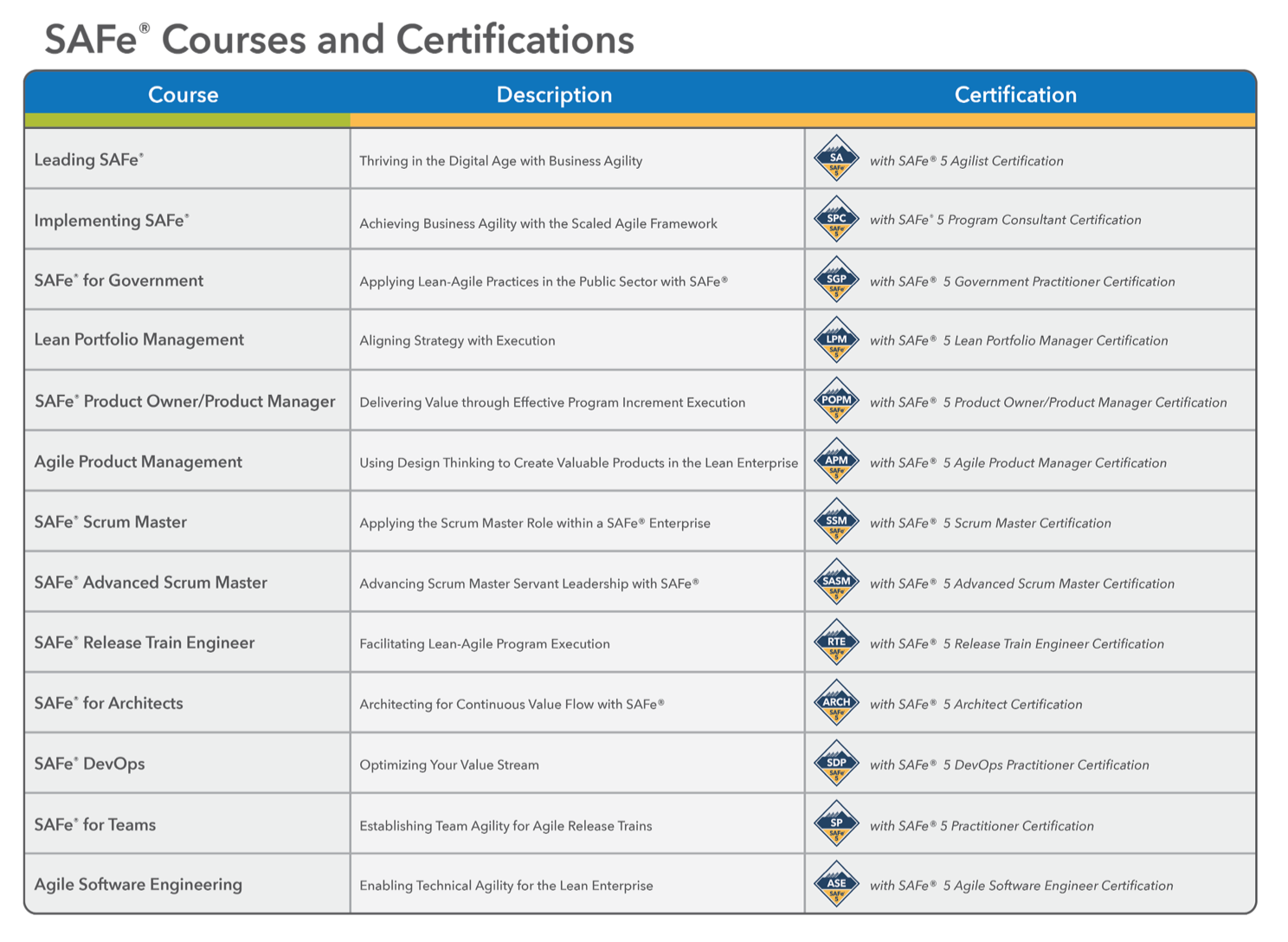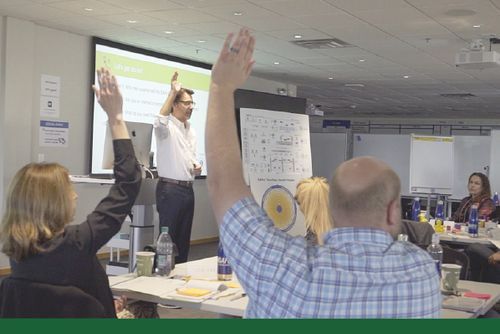The Scaled Agile Framework (SAFe) has become one of the most popular ways for organizations to implement agile practices. As more companies adopt SAFe, there is growing demand for professionals with SAFe certifications. This article provides a step-by-step guide on how to get SAFe certified.
What is SAFe Certification?
SAFe certification validates your knowledge and skills in implementing and scaling agile with the SAFe framework. It shows employers that you understand SAFe principles and practices and can apply them effectively.
There are various SAFe certifications for different roles like SAFe Agilist, SAFe Scrum Master, SAFe Product Owner/Product Manager, SAFe DevOps Practitioner etc. Each has its own course and exam.
SAFe certifications are offered by Scaled Agile Inc They are the only organization authorized to provide the official SAFe certifications.
Why Get SAFe Certified?
Here are some of the top reasons to get SAFe certified:
-
Get recognized for your SAFe skills and expertise. SAFe certifications are globally recognized.
-
Validate your knowledge to employers. 63% of employers require or prefer SAFe certification.
-
Increase your earning potential. Certified professionals can earn $13,000 more on average.
-
Enhance your career opportunities. SAFe certs open doors to new jobs, projects and leadership roles.
-
Help drive agile transformation in your organization
-
Expand your professional network by joining a community of over 1 million SAFe certified practitioners.
How to Get SAFe Certified?
Follow these steps to earn your SAFe certification:
1. Choose Your Certification
Pick the SAFe certification that aligns with your experience and career goals. Some top options:
-
SAFe Agilist (SA) – Foundation level, for those new to SAFe.
-
SAFe Practitioner (SP) – For those with experience working in SAFe teams and organizations.
-
SAFe Scrum Master (SSM) – For agile coaches and scrum masters.
-
SAFe Product Owner/Product Manager (POPM) – For product owners and product managers.
-
SAFe DevOps Practitioner (SDP) – For DevOps engineers and release train engineers.
-
SAFe Advanced Scrum Master (SASM) – For experienced scrum masters.
2. Take the Required Course
You must take the official course for your chosen certification from an authorized SAFe training provider. Courses are offered both online and in-person.
Courses range from 2-5 days and provide in-depth training on SAFe principles, values, practices, and competencies. You’ll get to learn from an experienced instructor.
Make sure to check the training calendar for course options. Public courses start from around $1,000. Enterprises can also request private onsite training.
3. Prepare for the Exam
Once you complete the course, you’ll get access to the exam preparation materials. This includes:
- Exam study guide
- Exam handbook
- Practice test
Use these resources to get ready for the exam. Go through the study guide and handbook to understand the exam content areas. Taking the practice tests helps assess your readiness.
Schedule your exam within 30 days of the course for maximum retention.
4. Pass the Certification Exam
SAFe certification exams are closed-book with multiple choice, true/false and matching questions. They test your conceptual, factual and applied knowledge of SAFe.
You need to pass the exam to achieve certification. Scores vary for different SAFe certs but you typically need a 65-80% score to pass.
If you don’t pass on the first attempt, you can retake the exam. Exam retake fees apply.
5. Receive Your Digital Badge
Once you pass the exam, you’ll immediately receive your SAFe certification digital badge. This badge validates your certification status and SAFe competency.
You can showcase your badge on social media, resumes, websites and email signatures. SAFe badges integrate with platforms like LinkedIn and Credly to verify your certification.
6. Maintain Your Certification
Your SAFe certification is valid for one year. To renew, you must take the latest version of the course and pass the exam again.
Stay up-to-date on new SAFe releases to maintain your certification. You can also earn renewal points through activities like online learning and events.
How Much Does SAFe Certification Cost?
The total cost for SAFe certification includes:
-
Course fee – Around $1000-$2000 on average for a 2-5 day public course. Enterprise private courses typically cost more.
-
Exam fee – Included with the course fee if you take the exam within 30 days. Otherwise $50 for the exam.
-
Retake fee – $50 for most exams. $250 for SAFe Practice Consultant.
So the total cost works out to $1000-$2000 on average. Confirm exact pricing with your training provider.
Choosing the Right Training Provider
Some factors to consider when picking SAFe training providers:
-
Delivery options – Online, in-person or onsite classes.
-
Location & schedules – Global providers offer more options.
-
Instructor profiles – Look for certified SAFe Program Consultants (SPCs) or SAFe Fellows.
-
Reviews – Check feedback scores and reviews from past trainees.
-
Pricing – Compare costs across providers.
-
Support – Email, phone and web support.
Leading SAFe training providers include Scaled Agile Inc, AgileVentures, Agile Hive, Agil4Ward, Lean Kanban Inc. and others.
Check the SAFe website for a complete directory of authorized partners.
Getting Your Employer to Sponsor SAFe Certification
If your company has adopted SAFe, they may be willing to pay for your certification for a few reasons:
-
It will improve your SAFe skills to better support their agile initiatives.
-
Having more SAFe certified employees boosts their transformation.
-
It shows their commitment to advancing your career development.
Here are some tips for getting employer sponsorship:
-
Explain how certification will immediately help you contribute more value in your current role.
-
Share how it aligns with your career goals at the company.
-
Outline the return on investment – like improved productivity, faster time-to-market, higher quality etc.
-
Offer to train other team members after you get certified.
-
Request them to cover the training and exam fees.
-
Have them provide time off to take the course and prepare for the exam.
With SAFe adoption growing rapidly, more employers are willing to invest in certification for their workforce.
Continuing Your SAFe Education
SAFe certification is a starting point, not the end goal. To keep progressing:
-
Take advanced SAFe courses – To specialize in new roles like Release Train Engineer, Enterprise Solution Architect etc.
-
Read books and blogs – Continue learning about real world SAFe implementations.
-
Attend SAFe events – Conferences, meetups and local gatherings.
-
Join the SAFe Community – Engage in forums and participate in local chapters.
-
Get additional certs – Like PMI-ACP, ScrumMaster, Lean Six Sigma etc.
-
Contribute to the Community – Volunteer, write blogs, help newcomers etc.
-
Renew certifications – Regularly maintain your SAFe certs to stay current.
SAFe certifications can give your agile career a major boost. They validate your expertise to employers and expand your professional opportunities.
Follow the steps in this guide to determine which SAFe certification is right for you. Attend the required course, prepare for the exam, and get certified.
With discipline and commitment, you can get SAFe certified within a month. Then continue growing your agile skills and experience.
So what are you waiting for? Advance your agile journey today by getting SAFe certified.

Open Doors with SAFe® Training and Certification
Nearly three-quarters of executives say that “the ability of their people to adapt, reskill, and assume new roles” is their top priority for navigating the future1. SAFe training and professional SAFe certifications can help you up-level your skills, empower teams, and bring agility to your day-to-day work. We make it simple to get started: Attend a course. Learn, study, and practice. Then get SAFe Certified.


Which Course Is Right for You?
Use our course finder to discover which course is right for you based on your role, goals, organization, and knowledge.

Find the course of your choice on our training calendar, and sign up for remote or in-person training on the dates and in the locations that work for you.

After you’ve completed your SAFe course, validate your skills and advance your career by becoming a certified SAFe professional.
Number of jobs in the US alone that ask for “Scaled Agile Framework” experience(2)
Minimum annual salary for 86 percent of SAFe-related jobs(3)
How SAFe ranks in popularity compared to other frameworks for scaling Agile(4)
How to get SAFe Certified | SAFe Certification Training | Edureka
How do I get safe certified?
SAFe training and professional SAFe certifications can help you up-level your skills, empower teams, and bring agility to your day-to-day work. We make it simple to get started: Attend a course. Learn, study, and practice. Then get SAFe Certified. Which Course Is Right for You?
Why should I get safe certified?
Becoming certified is the first step toward becoming part of a growing community of certified SAFe® professionals! Click these links for further information on the importance and benefits of becoming certified: SAFe Certification Benefits (3:44)
Do you need a safe certification?
Based on our research for the 2024 Careers Snapshot, we found that 62 percent of open SAFe roles required certifications, with others listing certification as strongly preferred. Because SAFe courses and exams cover Agile ways of working, SAFe certifications are useful in any Agile organization. Can I earn more with a SAFe certification?
Where can I get Safe Training & Certification?
SAFe training and certification are available online or through in-person training through these and other education providers: Advised Skills: Advised Skills is a consultancy and training services provider focused on Lean-agile transformation, agile strategy audit and implementation, and agile program/portfolio management.